HONDA PRELUDE 1992 Owners Manual
Manufacturer: HONDA, Model Year: 1992, Model line: PRELUDE, Model: HONDA PRELUDE 1992Pages: 225, PDF Size: 2.1 MB
Page 191 of 225
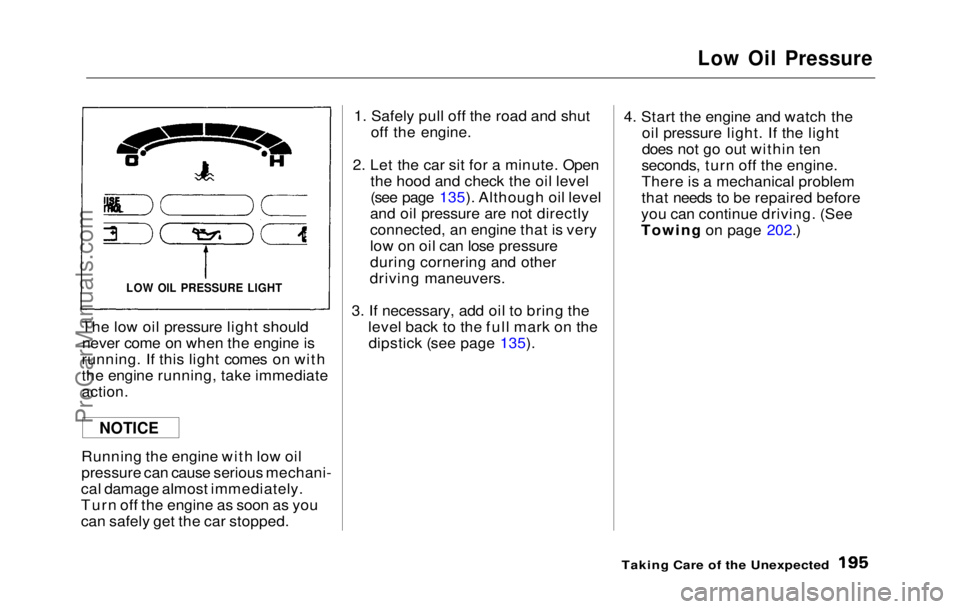
Low Oil Pressure
The low oil pressure light should never come on when the engine is
running. If this light comes on with
the engine running, take immediate
action.
Running the engine with low oil
pressure can cause serious mechani-
cal damage almost immediately.
Turn off the engine as soon as you
can safely get the car stopped. 1. Safely pull off the road and shut
off the engine.
2. Le
t
the car sit for a minute. Open
the hood and check the oil level
(see page 135). Although oil level
and oil pressure are not directly
connected, an engine that is very
low on oil can lose pressure
during cornering and other
driving maneuvers.
3. I f
necessary, add oil to bring the
level back to the full mark on the
dipstick (see page 135
).
4. Star t
the engine and watch the
oil pressure light. If the light
does not go out within ten
seconds, turn off the engine.
There is a mechanical problem
that needs to be repaired before
you can continue driving. (See
Towin g on
page 202 .
)
Taking Car e
of the Unexpected
LOW OIL PRESSURE LIGHT
NOTICEProCarManuals.comMain Menu Table of Contents s t
Page 192 of 225
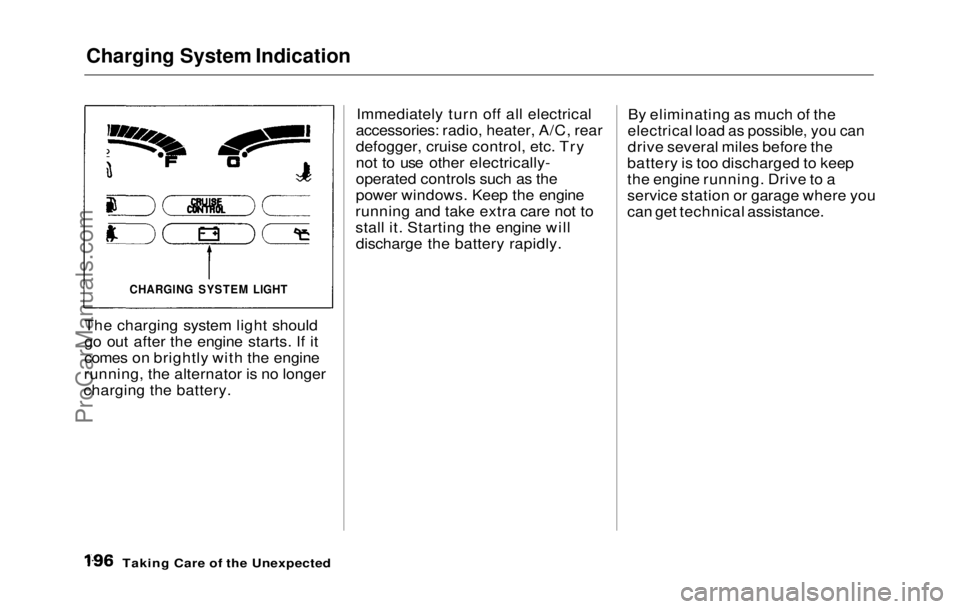
Charging System Indication
The charging system light should
go out after the engine starts. If it
comes on brightly with the engine
running, the alternator is no longer
charging the battery. Immediately turn off all electrical
accessories: radio, heater, A/C, rear
defogger, cruise control, etc. Try
not to use other electrically-
operated controls such as the
power windows. Keep the engine
running and take extra care not to
stall it. Starting the engine will discharge the battery rapidly. By eliminating as much of the
electrical load as possible, you can
drive several miles before the
battery is too discharged to keep
the engine running. Drive to a
service station or garage where you
can get technical assistance.
Taking Care of the Unexpected
CHARGING SYSTEM LIGHTProCarManuals.comMain Menu Table of Contents s t
Page 193 of 225
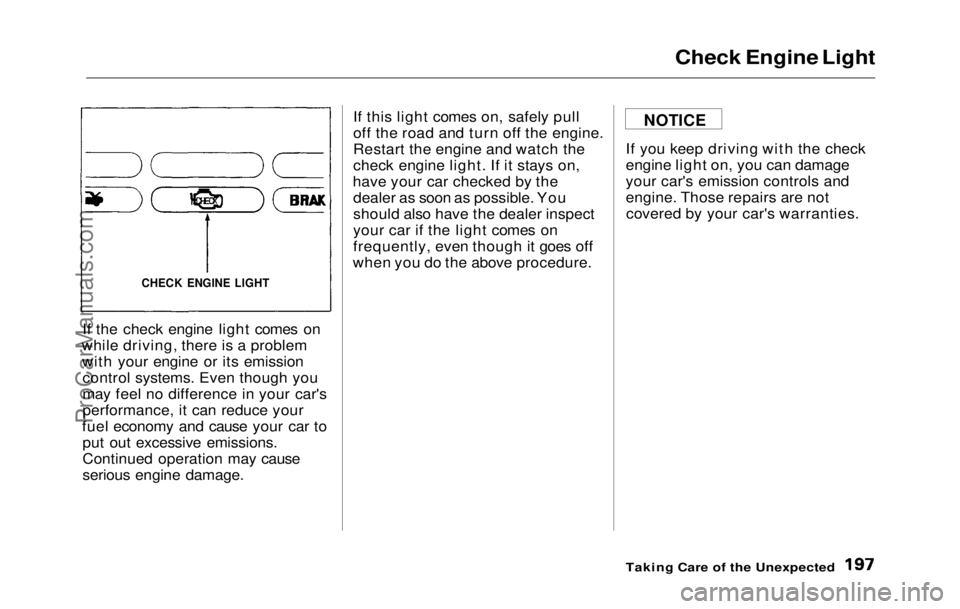
Check Engine Light
If the
check engine light comes on
while driving, there is a problem with your engine or its emissioncontrol systems. Even though you
may feel no difference in your car's
performance, it can reduce your
fuel economy and cause your car to put out excessive emissions.
Continued operation may cause
serious engine damage. If this light comes on, safely pull
off the road and turn off the engine.
Restart the engine and watch the
check engine light. If it stays on,
have your car checked by the dealer as soon as possible. You
should also have the dealer inspect
your car if the light comes on
frequently, even though it goes off
when you do the above procedure. If you keep driving with the check
engine light on, you can damage
your car's emission controls and
engine. Those repairs are not
covered by your car's warranties.
Taking Care of the Unexpected
CHECK ENGINE LIGHT
NOTICEProCarManuals.comMain Menu Table of Contents s t
Page 194 of 225
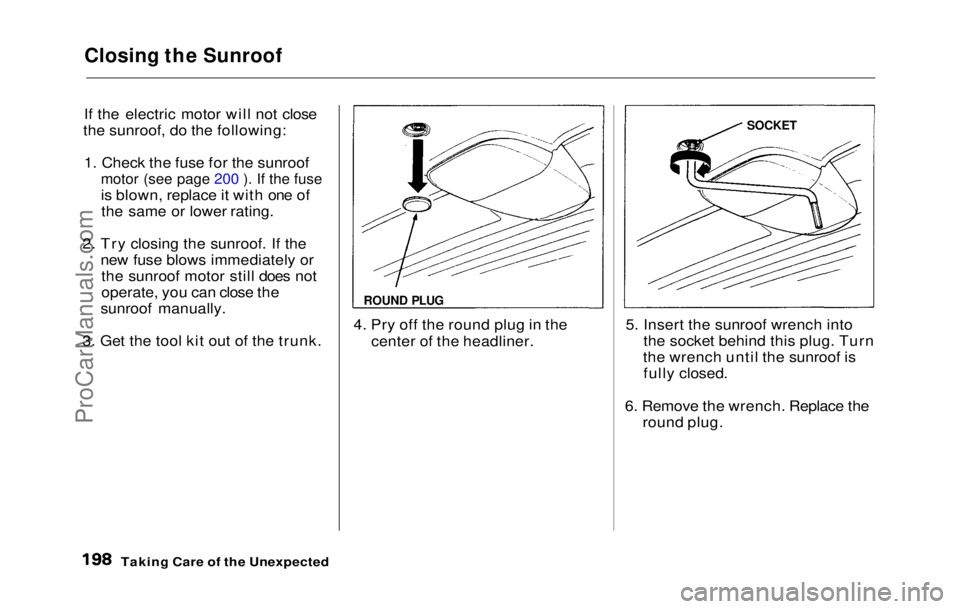
Closing the Sunroof
If the electric motor will not close
the sunroof, do the following:
1. Check the fuse for the sunroofmotor (see page 200 ). If the fuse
is blown, replace it with one ofthe same or lower rating.
2. Try
closing the sunroof. If the
new fuse blows immediately or the sunroof motor still does not
operate, you can close the
sunroof manually.
3. Get the tool kit out of the trunk. 4. Pry off the round plug in the
center of the headliner. 5. Insert the sunroof wrench into
the socket behind this plug. Turn
the wrench until the sunroof is fully closed.
6. Remove the wrench. Replace the round plug.
Taking Care of the Unexpected
ROUND PLUG
SOCKETProCarManuals.comMain Menu Table of Contents s t
Page 195 of 225
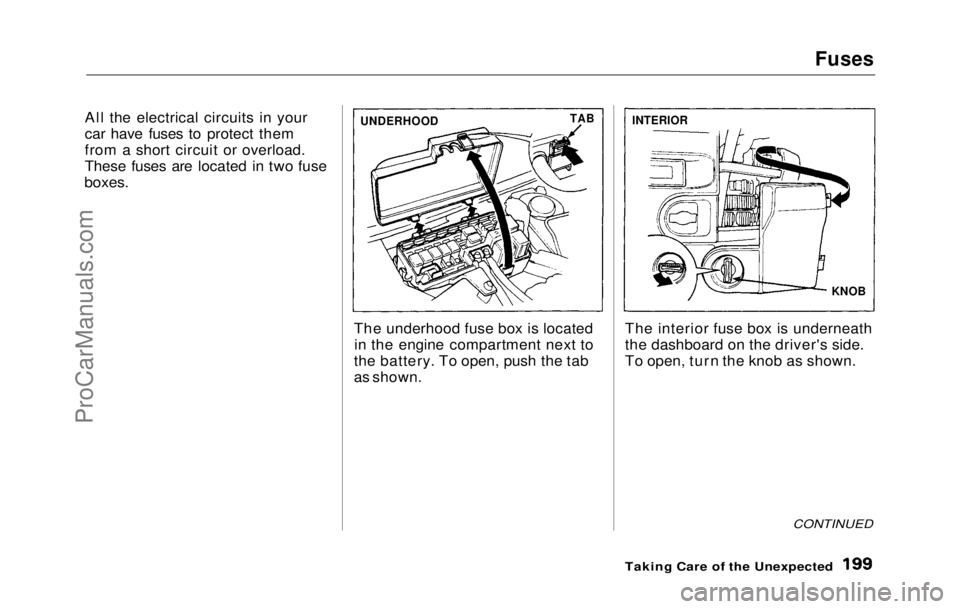
Fuses
All the electrical circuits in your
car have fuses to protect them
from a short circuit or overload.
These fuses are located in two fuse
boxes.
The underhood fuse box is locatedin the engine compartment next to
the battery. To open, push the tab
as shown.
The interior fuse box is underneath
the dashboard on the driver's side.
To open, turn the knob as shown.
CONTINUED
Taking Care of the Unexpected
UNDERHOOD
TAB
KNOB
INTERIORProCarManuals.comMain Menu Table of Contents s t
Page 196 of 225
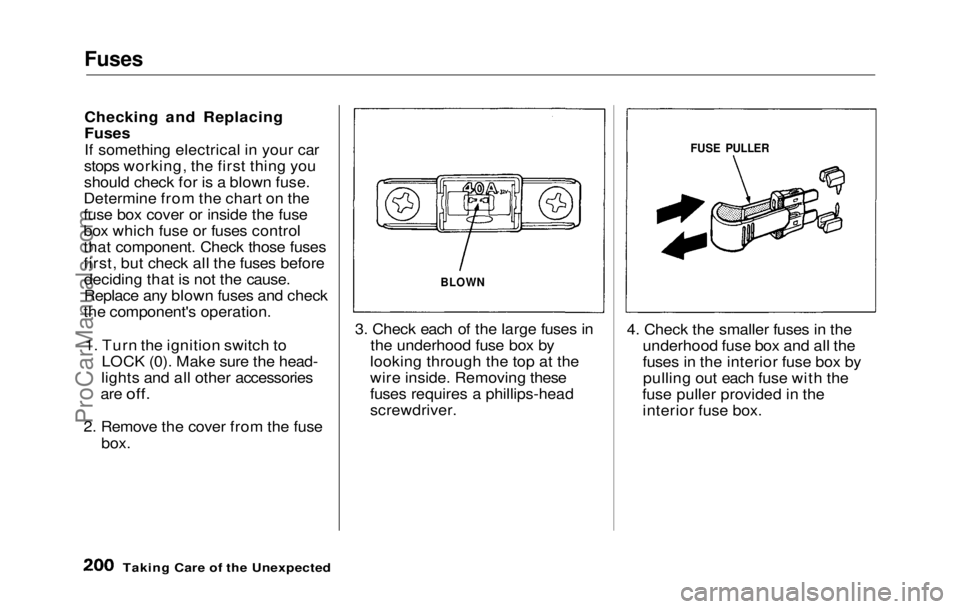
Fuses
Checking and Replacing
Fuses
If something electrical in your car
stops working, the first thing you
should check for is a blown fuse.
Determine from the chart on the
fuse box cover or inside the fuse
box which fuse or fuses control
that component. Check those fuses
first, but check all the fuses before deciding that is not the cause.
Replace any blown fuses and check
the component's operation.
1. Turn the ignition switch to LOCK (0). Make sure the head-
lights and all other accessories
are
off.
2. Remove the cover from the fuse box. 3. Check each of the large fuses in
the underhood fuse box by
looking through the top at the
wire inside. Removing these
fuses requires a phillips-head
screwdriver. 4. Check the smaller fuses in the
underhood fuse box and all the
fuses in the interior fuse box bypulling out each fuse with the
fuse puller provided in the interior fuse box.
Taking Care of the Unexpected
BLOWN
FUSE PULLERProCarManuals.comMain Menu Table of Contents s t
Page 197 of 225
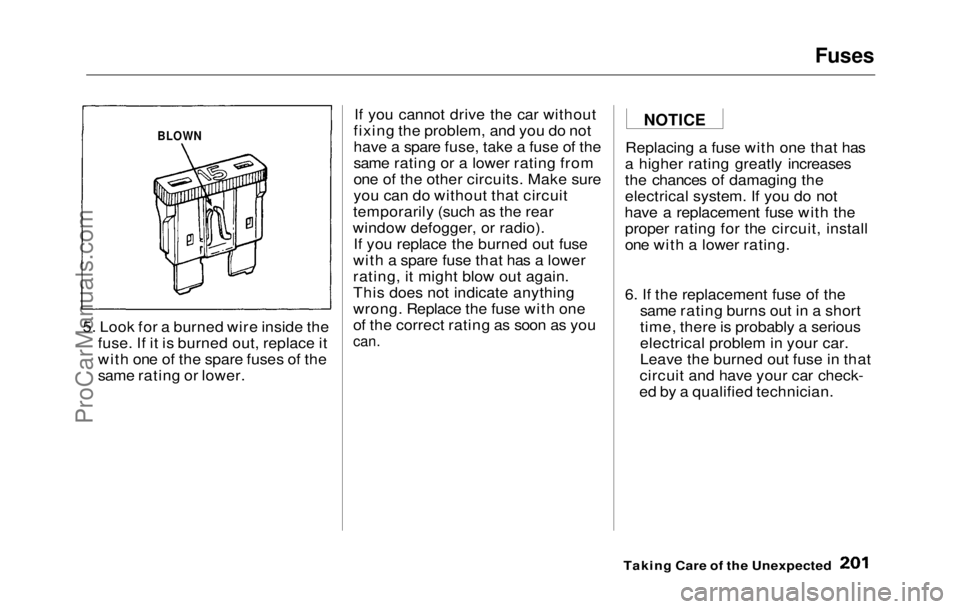
Fuses
5. Look for a burned wire inside the fuse. If it is burned out, replace it
with one of the spare fuses of the
same rating or lower. If you cannot drive the car without
fixing the problem, and you do not
have a spare fuse, take a fuse of the
same rating or a lower rating from
one of the other circuits. Make sure
you can do without that circuit
temporarily (such as the rear
window defogger, or radio). If you replace the burned out fuse
with a spare fuse that has a lower
rating, it might blow out again.
This does not indicate anything
wrong. Replace the fuse with one
of the correct rating as soon as you
can.
Replacing a fuse with one that has
a higher rating greatly increases
the chances of damaging the
electrical system. If you do not
have a replacement fuse with the proper rating for the circuit, install
one with a lower rating.
6. If the replacement fuse of the same rating burns out in a short
time, there is probably a serious
electrical problem in your car.
Leave the burned out fuse in that
circuit and have your car check-
ed by a qualified technician.
Taking Care of the Unexpected
BLOWN
NOTICEProCarManuals.comMain Menu Table of Contents s t
Page 198 of 225
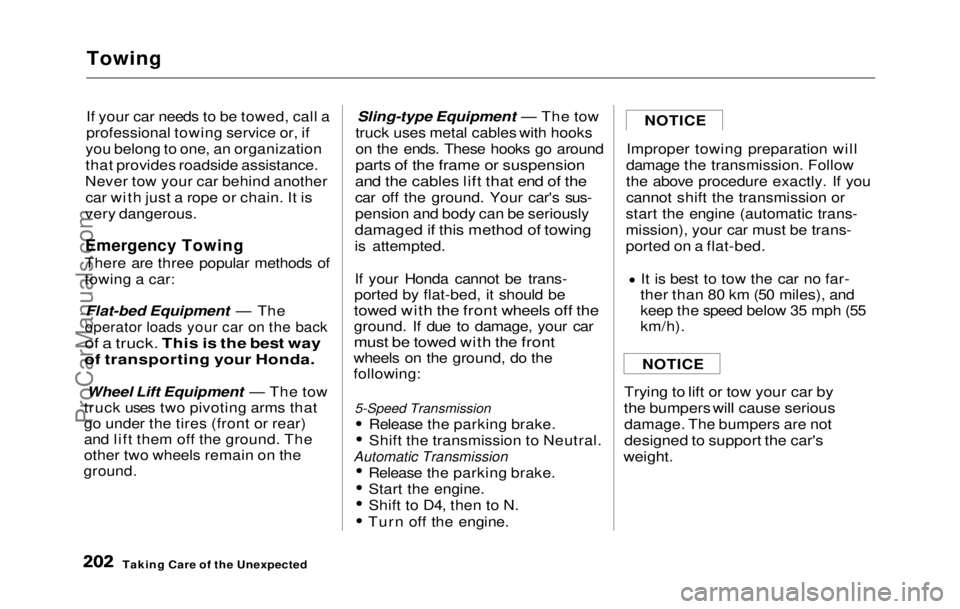
Towing
If your car needs to be towed, call a
professional towing service or, if
you belong to one, an organization
that provides roadside assistance.
Never tow your car behind another car with just a rope or chain. It is
very dangerous.
Emergency Towing
There are three popular methods of
towing a car:
Flat-bed Equipment — The
operator loads your car on the back
of a truck. This is the best way
of transporting your Honda.
Wheel Lift Equipment — The tow
truck uses two pivoting arms that
go under the tires (front or rear)
and lift them off the ground. The
other two wheels remain on the
ground.
Sling-type Equipment — The tow
truck uses metal cables with hooks
on th
e
ends. These hooks go around
parts of the frame or suspension
and the cables lift that end of the
car off the ground. Your car's sus-
pension and body can be seriously
damaged if this method
of towing
is attempted.
If your Honda cannot be trans-
ported by flat-bed, it should be
towed with the front wheels off the
ground. If due to damage, your car
must be towed with the front
wheels on the ground, do the
following:
5-Speed Transmission
Release the parking brake.
Shift the transmission to Neutral.
Automatic Transmission
Release the parking brake.
Start the engine.
Shift to D4, then to N.
Turn off the engine. Improper towing preparation will
damage the transmission. Follow
the above procedure exactly. If you
cannot shift the transmission or
start the engine (automatic trans-
mission), your car must be trans-
ported on a flat-bed. It is best to tow the car no far-
ther than 80 km (50 miles), and
keep the speed below 35 mph (55
km/h).
Trying to lift or tow your car by
the bumpers will cause serious
damage. The bumpers are not
designed to support the car's
weight.
Taking Care
of the Unexpected NOTICE
NOTICEProCarManuals.comMain Menu Table of Contents s t
Page 199 of 225
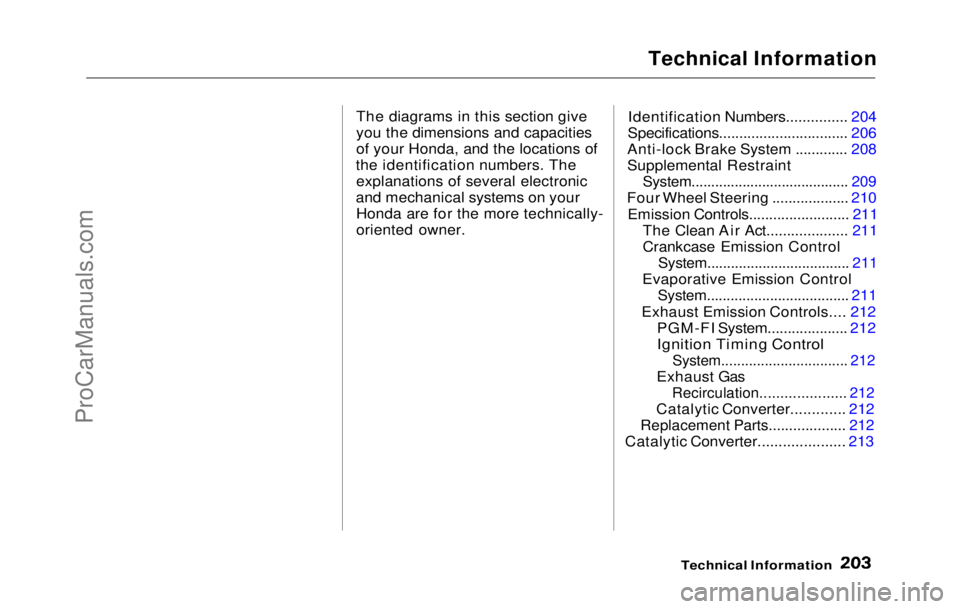
Technical Information
The diagrams in this section give
you the dimensions and capacities
of your Honda, and the locations of
the identification numbers. The explanations of several electronic
and mechanical systems on your Honda are for the more technically-
oriented owner. Identification Numbers............... 204
Specifications................................ 206
Anti-lock Brake System ............. 208
Supplemental Restraint
System........................................ 209
Four Wheel Steering ................... 210
Emission Controls......................... 211 The Clean Air Act.................... 211
Crankcase Emission Control
System.................................... 211
Evaporative Emission Control
System.................................... 211
Exhaust Emission Controls.... 212 PGM-FI System.................... 212
Ignition Timing Control
System................................ 212
Exhaust Gas
Recirculation..................... 212
Catalytic Converter............. 212
Replacement Parts................... 212
Catalytic Converter..................... 213
Technical InformationProCarManuals.comMain Menu s t
Page 200 of 225
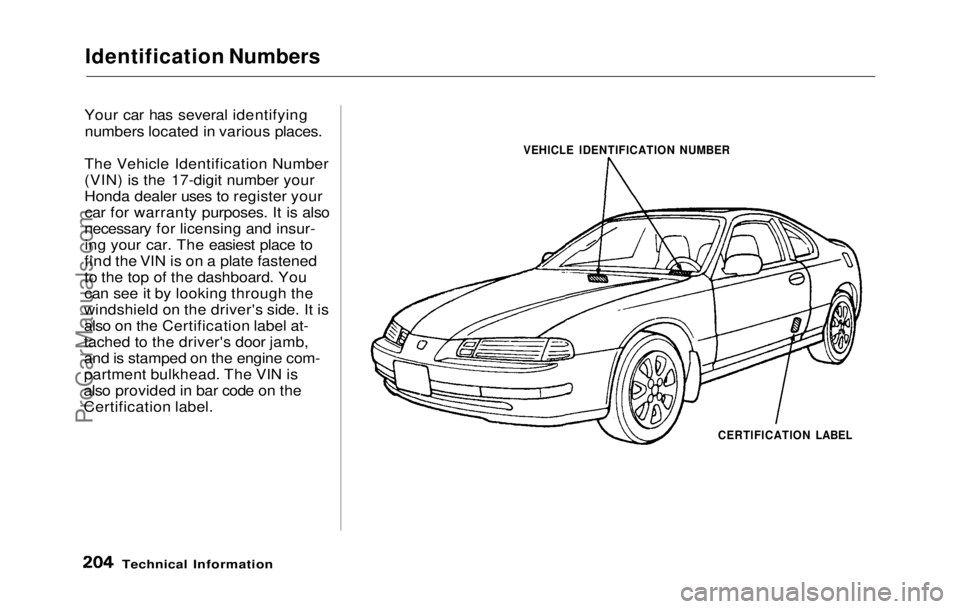
Identification Numbers
Your car has several identifying numbers located in various places.
The Vehicle Identification Number
(VIN) is the 17-digit number your
Honda dealer uses to register your car for warranty purposes. It is also
necessary for licensing and insur- ing your car. The easiest place to
find the VIN is on a plate fastened
to the top of the dashboard. You
can see it by looking through the
windshield on the driver's side. It is
also on the Certification label at-
tached to the driver's door jamb,
and is stamped on the engine com-
partment bulkhead. The VIN is
also provided in bar code on the
Certification label.
Technical Information
VEHICLE IDENTIFICATION NUMBER
CERTIFICATION LABELProCarManuals.comMain Menu Table of Contents s t